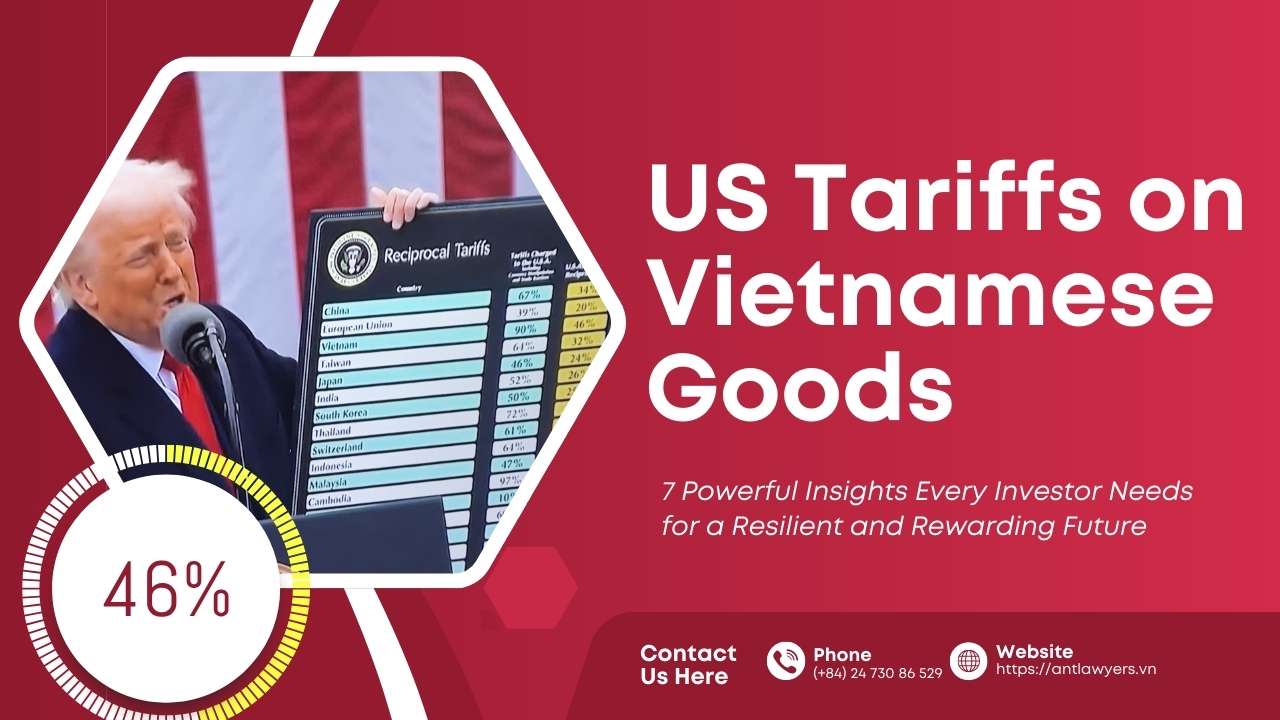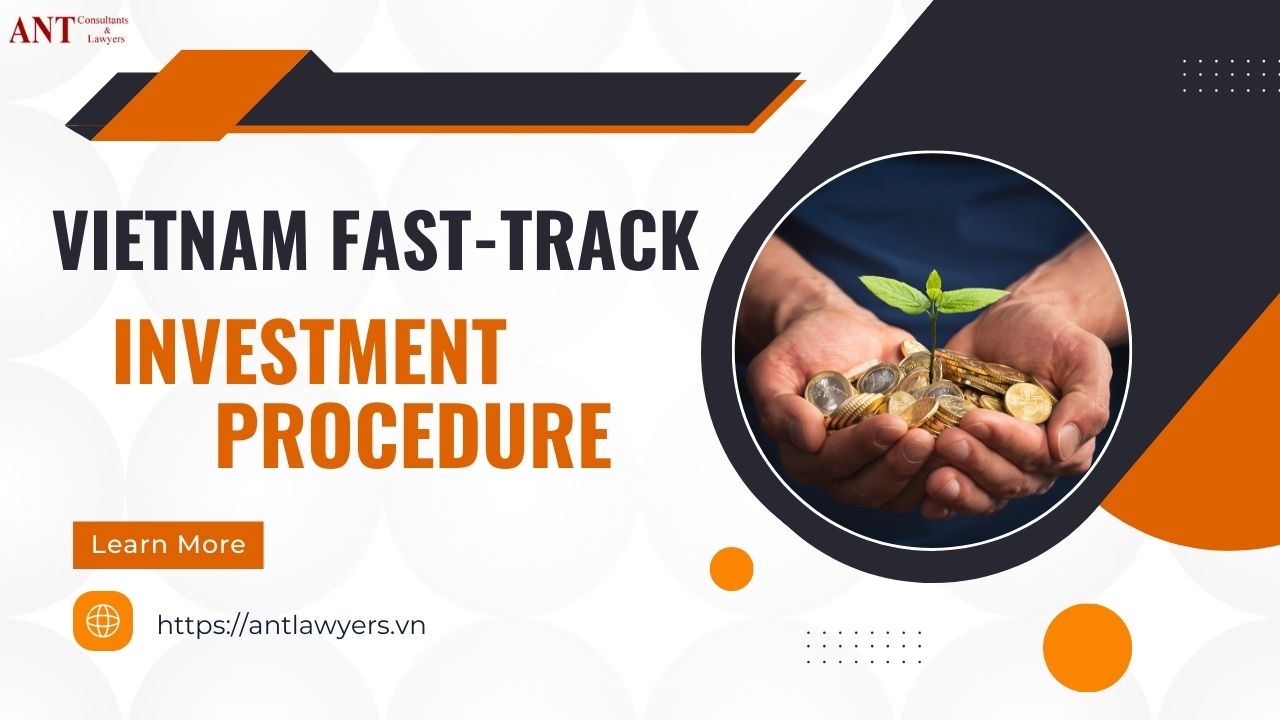US Tariffs on Vietnamese Goods: 7 Powerful Insights Every Investor Needs for a Resilient and Rewarding Future


The recent imposition of US tariffs on Vietnamese goods has stirred both caution and opportunity within Vietnam’s investment landscape. While surface level reactions may see this as a threat, seasoned investors recognize it as a pivotal moment, a time to reassess, realign, and reaffirm confidence in Vietnam’s long-term growth potential.
For foreign investors, those who have already invested or are considering entering and doing business in Vietnam, it is important to have a comprehensive, realistic, and forward-looking legal and strategic analysis.
We hope from here, together we will understand the regulatory context behind the US tariffs on Vietnamese goods, their actual and anticipated effects on supply chains, and the tactical steps investors can take to navigate the situation with clarity and advantage.
Understanding the Policy Shift: Why the US Imposed Tariffs on Vietnamese Goods
On April 2, 2025, the United States announced a sweeping policy change, imposing new tariffs on Vietnamese goods, with some rates reaching up to 46%. The justification, as outlined in the White House fact sheet, revolves around concerns over economic sovereignty, trade deficits, and protection of domestic manufacturing.
These US tariffs on Vietnamese goods were not introduced in isolation. Rather, they were part of a broader initiative targeting several nations perceived to have “excessive and unfair trade advantages” with the United States.
The legal foundation was based on the International Emergency Economic Powers Act (IEEPA), which allows the US President to declare an economic emergency and impose trade-related restrictions, including tariffs.
For foreign investors in Vietnam, the move raised fundamental questions: Is Vietnam still a reliable production base? Will these tariffs reshape future export strategies? The answer lies not in reacting to uncertainty, but in understanding the rules and adapting to them strategically.
The Legal Landscape: How the US Tariffs on Vietnamese Goods Align with Law
The imposition of US tariffs on Vietnamese goods triggered debate in legal circles worldwide. Under WTO agreements, particularly the General Agreement on Tariffs and Trade (GATT) and the Agreement on Subsidies and Countervailing Measures, member countries are allowed to impose countervailing duties, but only after transparent investigations demonstrating evidence of subsidization and harm.
In the current case, many observers argue that the United States acted without the usual notice-and-comment periods or bilateral consultations. Vietnam, as a WTO member, has the right to seek consultations and, if necessary, pursue dispute resolution through the WTO Dispute Settlement Body.
From an investor’s point of view, the key legal takeaway is this: the tariffs may face formal legal challenge, and their permanence is far from guaranteed. However, in the short term, their economic effect must be accounted for in all operational and strategic plans.
Supply Chain Exposure: Identifying the Real Risk to Your Investments
Whether you’ve invested in manufacturing, logistics, or sourcing platforms in Vietnam, the new US tariffs on Vietnamese goods require a careful re-evaluation of exposure.
Key sectors most affected include:
- Furniture and wood products
- Apparel and footwear
- Seafood and agricultural commodities
- Consumer electronics and components
If your production is destined primarily for the US market, then tariffs of this scale could erode margins, delay shipments, or even lead to order cancellations. It is important to have a clear picture of their risk exposure to begin to find solutions.
Start with a tariff impact map: assess which products are affected, at what rates, and whether there are possible reclassification options.
Engage legal counsel familiar with customs law in both Vietnam and the US.
Contractual Risk: Are Your Agreements Shielding You or Exposing You?
One of the most underestimated consequences of US tariffs on Vietnamese goods is the impact on existing commercial agreements. Foreign investors often structure long-term contracts between Vietnamese subsidiaries and buyers in the US. These contracts may fix prices, delivery schedules, and tax responsibilities, yet few consider a scenario where external tariffs spike suddenly by over 40%.
Legal audits of all export-related contracts are now essential. Questions to ask:
- Does your contract fix sale prices regardless of external duties?
- Are there force majeure clauses that cover government-imposed tariffs?
- Is there a mechanism for renegotiation in the case of regulatory changes?
Forward-thinking investors are already incorporating “tariff flexibility clauses” into new contracts. These provisions allow parties to revisit prices or terminate without penalty if geopolitical or regulatory events drastically change the cost structure.
Navigating the Short-Term:
In response to the US tariffs on Vietnamese goods, the investors would consider taking proactive steps such as:
- Diversifying export markets: Leveraging Vietnam’s participation in a mumber of Free Trade Agreements, including the EU-Vietnam FTA (EVFTA), CPTPP, and RCEP, to shift focus to Europe, Japan, and regional ASEAN countries.
- Engaging in origin engineering: Rethinking production layouts to legally alter the country of origin for finished goods.
- Engaging with Vietnamese government trade facilitation programs: Several agencies have launched assistance initiatives for exporters impacted by the US tariffs.
- Investing in product innovation: Products with strong IP protections or unique market appeal are often less price-sensitive and more resistant to tariff pressure.
Vietnam’s fundamentals remain strong: stable politics, a young and skilled workforce, and a proven record in infrastructure for manufacturing and logistics.
Will These US Tariffs on Vietnamese Goods Last?
The future of the US tariffs on Vietnamese goods is uncertain. On the one hand, they stem from an executive order and may be rolled back or modified by a future administration or through successful WTO litigation. On the other hand, global trends toward deglobalization and economic nationalism suggest that such measures may become more frequent.
Legally, Vietnam has already initiated preliminary discussions with the US via established dialogue mechanisms, including the US-Vietnam Trade and Investment Framework Agreement (TIFA). If consultations fail, WTO action is likely. Investors should monitor these legal channels closely, not only to forecast future tariff policies but to understand when and how to adjust their operations.
Investment Opportunities Despite US Tariffs on Vietnamese Goods
It’s essential to emphasize that US tariffs on Vietnamese goods, but Vietnam is still considered a top-tier investment destination.
In fact, in many ways, Vietnam is better positioned than peers due to several enduring advantages:
- FTAs continue to provide low- or zero-tariff access to over 50 countries, including some of the largest economies in the world.
- Vietnam’s cost competitiveness remains high, especially compared to rising labor costs in China and growing instability in other parts of Asia.
- Strong government support for FDI and legal reform (particularly in administrative procedures, IP protection, and dispute resolution) signals a maturing investment environment.
For foreign investors with a medium- to long-term horizon, ones with positive mind would take this event as it is and find solutions to adapt.
What Investors Should Do Next
Based on our analysis of the US tariffs on Vietnamese goods, foreign investors would consider the following steps:
- Conduct a tariff exposure audit across your product portfolio.
- Review all export-related contracts to identify risks and gaps.
- Engage in direct dialogue with trade associations and Vietnamese government authorities to stay informed.
- Explore market diversification with new customers outside the US.
- Implement contract and compliance.
- Invest in legal capacity, both in-house and through external advisors, to navigate international trade law.
- Evaluate the viability of restructuring parts of the supply chain for origin control or value-added enhancements.
- Prepare internal communication strategies to manage expectations of global headquarters, clients, and stakeholders.
- Turning Trade Tensions into Strategic Opportunity
In every disruption lies opportunity. The emergence of US tariffs on Vietnamese goods is undeniably a test of resilience for both Vietnamese industries and their international investors. But it also represents a defining moment, one where proactive businesses can separate themselves from competitors through legal foresight, strategic agility, and operational excellence.
Vietnam is not a passive player in global trade, it is a dynamic, reforming, and increasingly influential economy. Its response to these tariffs, and the response of the investors who believe in it, will shape the next chapter of regional economic development.
About ANT Lawyers, a Law Firm in Vietnam
We help clients overcome cultural barriers and achieve their strategic and financial outcomes, while ensuring the best interest rate protection, risk mitigation and regulatory compliance. ANT lawyers has lawyers in Ho Chi Minh city, Hanoi, and Danang, and will help customers in doing business in Vietnam.
How ANT Lawyers Could Help Your Business?
You could reach ANT Lawyers in Vietnam for advice via email ant@antlawyers.vn or call our office at (+84) 24 730 86 529
Recent Posts
6 Smart Moves to Improve ESG for Exporters in Vietnam and Unlock Global Trade Advantages
The World Is Watching You have the product. The factory is certified. Your logistics are…
7 Essential Truths to Open an Indirect Investment Account in Vietnam and Grow with Confidence
Do you want to invest overseas into Vietnam? Do you want to open an indirect…
5 Crucial Facts About ESG Laws in Vietnam That Could Save Your Business and Reputation
The Business World Is Changing Fast Rules are shifting. Expectations are rising. Eyes are watching. …
7 Powerful Reasons Why ESG Compliance in Vietnam Will Win You Trust, Growth, and Global Clients
Trust matters. Today, more than ever. Across industries, many companies are now being asked. directly…
7 Bold Reasons Why Tokenization in Vietnam Could Transform Your Future
Change is coming. Quietly. Digitally. Rapidly. Let’s imagine the situation, which assets are no longer…
Vietnam P2P Lending: 5 Bold Reasons Why Decree 94/2025 Could Empower Millions or Backfire?
A New Financial Chapter Begins in Vietnam One person lends. Another borrows. It’s that simple.…





